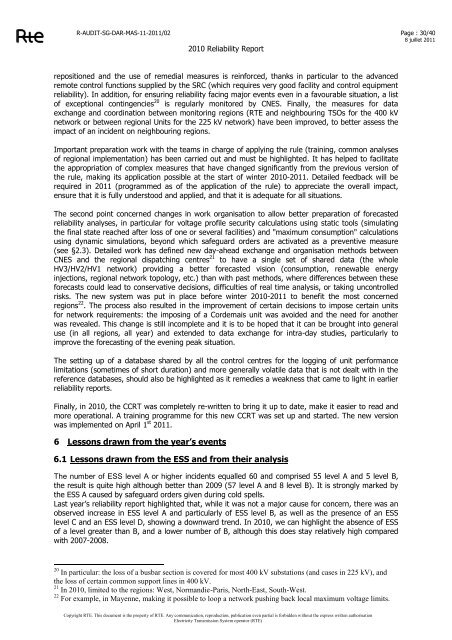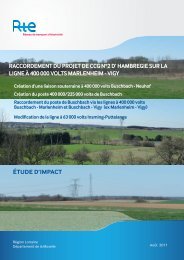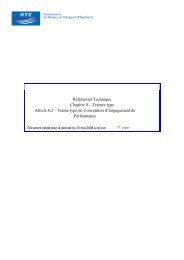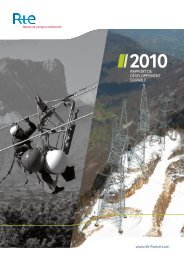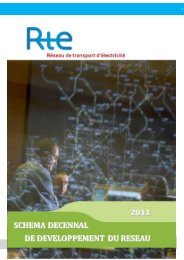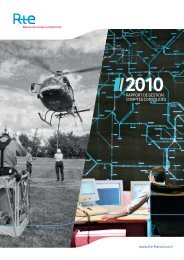Power System Reliability Report - RTE
Power System Reliability Report - RTE
Power System Reliability Report - RTE
- No tags were found...
Create successful ePaper yourself
Turn your PDF publications into a flip-book with our unique Google optimized e-Paper software.
R-AUDIT-SG-DAR-MAS-11-2011/022010 <strong>Reliability</strong> <strong>Report</strong>Page : 30/408 juillet 2011repositioned and the use of remedial measures is reinforced, thanks in particular to the advancedremote control functions supplied by the SRC (which requires very good facility and control equipmentreliability). In addition, for ensuring reliability facing major events even in a favourable situation, a listof exceptional contingencies 20 is regularly monitored by CNES. Finally, the measures for dataexchange and coordination between monitoring regions (<strong>RTE</strong> and neighbouring TSOs for the 400 kVnetwork or between regional Units for the 225 kV network) have been improved, to better assess theimpact of an incident on neighbouring regions.Important preparation work with the teams in charge of applying the rule (training, common analysesof regional implementation) has been carried out and must be highlighted. It has helped to facilitatethe appropriation of complex measures that have changed significantly from the previous version ofthe rule, making its application possible at the start of winter 2010-2011. Detailed feedback will berequired in 2011 (programmed as of the application of the rule) to appreciate the overall impact,ensure that it is fully understood and applied, and that it is adequate for all situations.The second point concerned changes in work organisation to allow better preparation of forecastedreliability analyses, in particular for voltage profile security calculations using static tools (simulatingthe final state reached after loss of one or several facilities) and "maximum consumption" calculationsusing dynamic simulations, beyond which safeguard orders are activated as a preventive measure(see §2.3). Detailed work has defined new day-ahead exchange and organisation methods betweenCNES and the regional dispatching centres 21 to have a single set of shared data (the wholeHV3/HV2/HV1 network) providing a better forecasted vision (consumption, renewable energyinjections, regional network topology, etc.) than with past methods, where differences between theseforecasts could lead to conservative decisions, difficulties of real time analysis, or taking uncontrolledrisks. The new system was put in place before winter 2010-2011 to benefit the most concernedregions 22 . The process also resulted in the improvement of certain decisions to impose certain unitsfor network requirements: the imposing of a Cordemais unit was avoided and the need for anotherwas revealed. This change is still incomplete and it is to be hoped that it can be brought into generaluse (in all regions, all year) and extended to data exchange for intra-day studies, particularly toimprove the forecasting of the evening peak situation.The setting up of a database shared by all the control centres for the logging of unit performancelimitations (sometimes of short duration) and more generally volatile data that is not dealt with in thereference databases, should also be highlighted as it remedies a weakness that came to light in earlierreliability reports.Finally, in 2010, the CCRT was completely re-written to bring it up to date, make it easier to read andmore operational. A training programme for this new CCRT was set up and started. The new versionwas implemented on April 1 st 2011.6 Lessons drawn from the year’s events6.1 Lessons drawn from the ESS and from their analysisThe number of ESS level A or higher incidents equalled 60 and comprised 55 level A and 5 level B,the result is quite high although better than 2009 (57 level A and 8 level B). It is strongly marked bythe ESS A caused by safeguard orders given during cold spells.Last year‟s reliability report highlighted that, while it was not a major cause for concern, there was anobserved increase in ESS level A and particularly of ESS level B, as well as the presence of an ESSlevel C and an ESS level D, showing a downward trend. In 2010, we can highlight the absence of ESSof a level greater than B, and a lower number of B, although this does stay relatively high comparedwith 2007-2008.20 In particular: the loss of a busbar section is covered for most 400 kV substations (and cases in 225 kV), andthe loss of certain common support lines in 400 kV.21 In 2010, limited to the regions: West, Normandie-Paris, North-East, South-West.22 For example, in Mayenne, making it possible to loop a network pushing back local maximum voltage limits.Copyright <strong>RTE</strong>. This document is the property of <strong>RTE</strong>. Any communication, reproduction, publication even partial is forbidden without the express written authorisationElectricity Transmission <strong>System</strong> operator (<strong>RTE</strong>)


